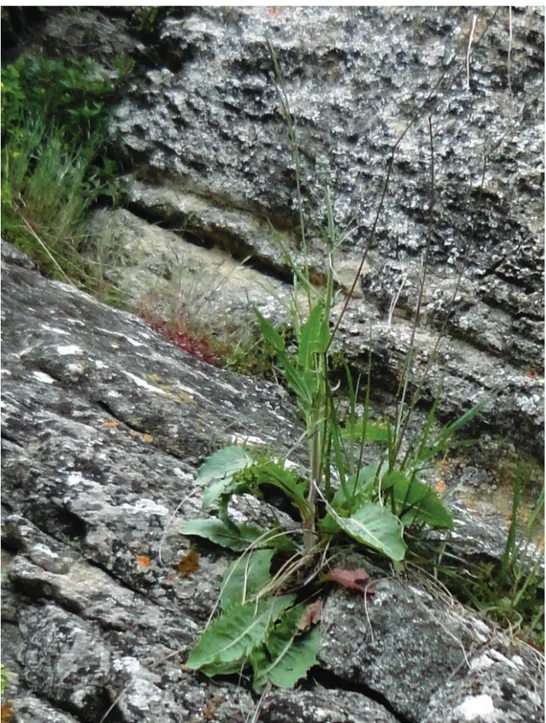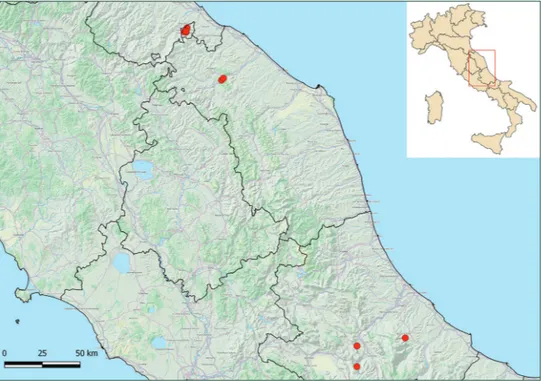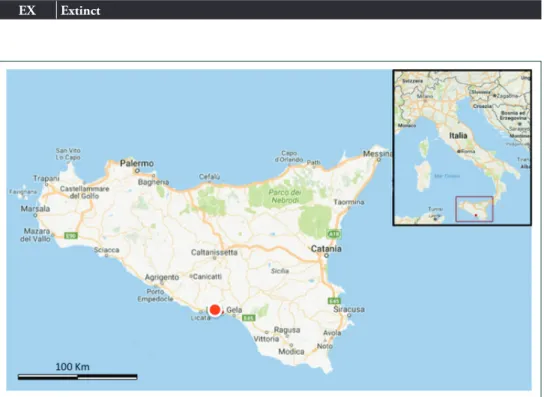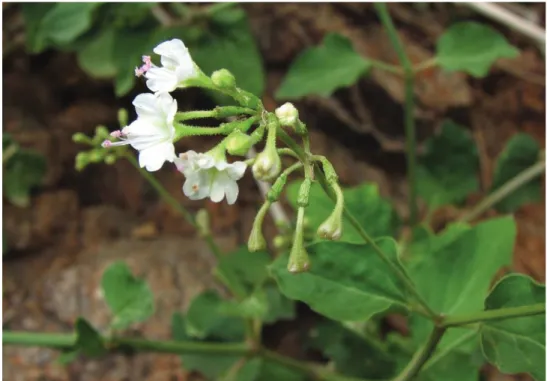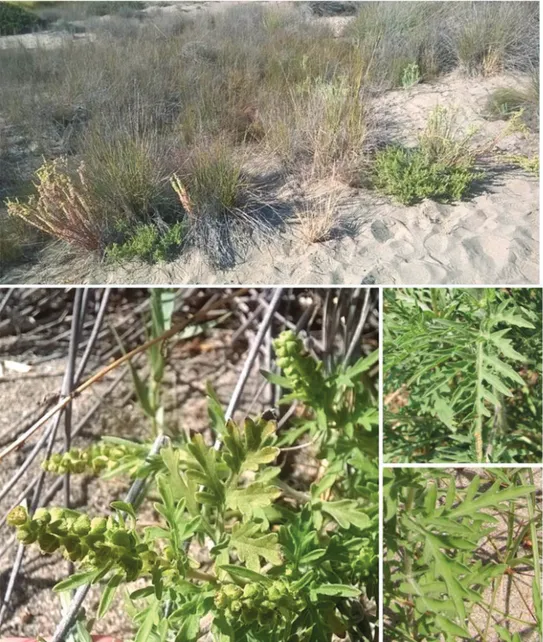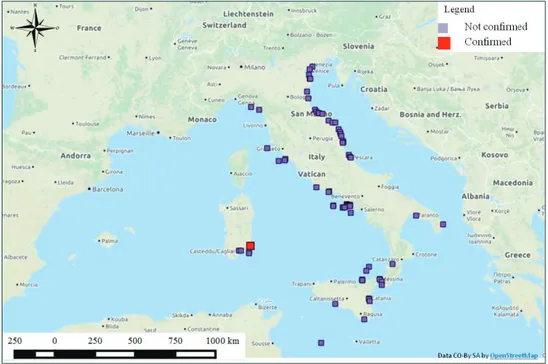Global and Regional IUCN Red List Assessments: 3
Simone Orsenigo1, Giovanni Astuti2, Fabrizio Bartolucci3, Sandra Citterio4,Fabio Conti3, Juan A. Garrido-Becerra5, Rodolfo Gentili4,
Gianpietro Giusso del Galdo6, Juan F. Jiménez-Martínez7, Gerhard Karrer8,
Agustín Lahora5, Fabián Martínez-Hernández5, Antonio J. Mendoza-Fernández5,
María E. Merlo5, Chiara Montagnani4, Juan Mota5, Gianluca Nicolella9,
Francisco J. Pérez-García5, Lorenzo Peruzzi2, Jesús Robles10, Francesco Roma-Marzio2,
Esteban Salmerón-Sánchez5, Pedro Sánchez-Gómez7, Lluís Serra11,12,
Adriano Stinca13,14, Giuseppe Fenu15
1 Department of Agricultural and Environmental Sciences - Production, Landscape, Agroenergy, University
of Milan, Milan, 20122, Italy 2 Department of Biology, University of Pisa, Pisa, 56126, Italy 3 Scuola di Bioscienze e Medicina Veterinaria, University of Camerino–Centro Ricerche Floristiche dell’Appennino, Parco Nazionale del Gran Sasso e Monti della Laga, 67021 Barisciano (L’Aquila), Italy 4 Department of Earth and Environmental Sciences, University of Milano Bicocca, Milan, 20126, Italy 5 Department of Biology and Geology-CECOUAL, University of Almería, 04120, Almería, Spain 6 Department of Biological, Geological and Environmental Sciences, Sect. Plant Biology, University of Catania, 95125 Catania, Italy 7 Department of Plant Biology, University of Murcia, 30003, Murcia, Spain 8 Department of Integrative Biology and Bio-diversity Research, University of Natural Resources and Life Sciences, 1180, Wien, Austria 9 Department of Environmental Biology, University of Rome “La Sapienza”, 00185 Roma 10 Oficina de Impulso Socioeconómi-co del Medio Ambiente-OISMA, Consejería de Agua, Agricultura y Medio Ambiente, Comunidad Autónoma de la Región de Murcia, 30157, Murcia, Spain 11 Generalitat Valenciana, Conselleria d’Agricultura, Medi Ambient, Canvi Climàtic i Desenvolupament Rural, SS.TT. d’Alacant, 03071, Alicante, Spain 12 Estación Científica Font Roja Natura UA, University of Alicante, 03690, San Vicente del Raspeig, Alicante, Spain
13 Department of Agriculture, University of Naples Federico II, 80055 Portici (Napoli), Italy 14 Department
Environmental, Biological and Pharmaceutical Sciences and Technologies, University of Campania Luigi Van-vitelli, 81100, Caserta, Italy 15 Centre for the Conservation of Biodiversity (CCB), Department of Life and Environmental Sciences, University of Cagliari, Cagliari, 09123, Italy
Corresponding author: Simone Orsenigo ([email protected])
Academic editor: R. Lansdown | Received 19 April 2017 | Accepted 24 April 2017 | Published 7 June 2017
Citation: Orsenigo S, Astuti G, Bartolucci F, Citterio S, Conti F, Garrido-Becerra JA, Gentili R, del Galdo GG, Jiménez-Martínez JF, Karrer G, Lahora A, Jiménez-Martínez-Hernández F, Mendoza-Fernández AJ, Merlo ME, Montagnani C, Mota J, Nicolella G, Pérez-García FJ, Peruzzi L, Robles J, Roma-Marzio F, Salmerón-Sánchez E, Sánchez-Gómez P, Serra L, Stinca A, Fenu G (2017) Global and Regional IUCN Red List Assessments: 3. Italian Botanist 3: 83–98. doi: 10.3897/ italianbotanist.3.13303
http://italianbotanist.pensoft.net
Copyright Simone Orsenigo et al. This is an open access article distributed under the terms of the Creative Commons Attribution License (CC BY 4.0), which permits unrestricted use, distribution, and reproduction in any medium, provided the original author and source are credited.
Simone Orsenigo et al. / Italian Botanist 3: 83–98 (2017)
84
Abstract
In this contribution, the conservation status assessment of four vascular plants are presented according to IUCN categories and criteria. It includes the assessment at global level of Crepis lacera Ten subsp. titani (Pamp.) Roma-Marzio, G.Astuti & Peruzzi and Anthyllis hermanniae L. subsp. sicula Brullo & Giusso and the regional assessment of Commicarpus plumbagineus (Cav.) Standl. (Spain and Europe) and Ambrosia
maritima L. (Italy).
Keywords
conservation, extinction risk, IUCN protocol, threats
Introduction
The text of the global and regional assessment should be submitted electronically to Simone Orsenigo ([email protected]) or to Giuseppe Fenu ([email protected]); text up to 8000 characters in length (space included) must include a distribution map and a picture of the assessed species.
Crepis lacera Ten. subsp. titani (Pamp.) Roma-Marzio, G.Astuti & Peruzzi
Global assessment
Taxonomy and nomenclature Order: Asterales Family: Asteraceae
Crepis lacera Ten. subsp. titani (Pamp.) Roma-Marzio, G.Astuti & Peruzzi, Phytotaxa
208(1): 50 (2015)
≡ Crepis lacera f. titani Pamp., Boll. Mus. Republ. San Marino 4: 118 (1920) ≡ Crepis lacera var. titani (Pamp.) Fiori, Nuov. Fl. Italia 2: 839 (1928)
Common name: Radicchiella del Monte Titano (It)
Geographic distribution range: Crepis lacera subsp. titani (Fig. 1) is an Italian en-demic, confined to Marche (extending to San Marino Republic) and Abruzzo regions (Peruzzi et al. 2014 online updates, Roma-Marzio et al. 2015). To date, this taxon is known from 9 localities, which are split into two main groups in Central Italy that could be considered as separate sub-populations due to their geographical separation.
The northernmost group (including the locus classicus) is located in part within the borders of the San Marino Republic and in part within the Marche region (Natural Reserve of “Gola del Furlo”). The second one is located in southern Abruzzo (Gole del Sagittario National Reserve; Gole di San Venanzio within the Sirente-Velino Regional Park, and Vallone di Pennapiedimonte within the Majella National Park) (Roma-Mar-zio et al. 2015) (Fig. 2).
Figure 1. Individual in bud of Crepis lacera subsp. titani on limestone cliffs of Monte Titano (San Marino
Republic). Photograph by L. Peruzzi.
Biology: Plant growth form: perennial (hemicryptophyte)
Flowering time: From May to July
Simone Orsenigo et al. / Italian Botanist 3: 83–98 (2017)
86
Habitat and Ecology: The preferred habitat of Crepis lacera subsp. titani is repre-sented by stony pastures and calcareous cliffs. This species typically occurs in chasmophyte communities on limestone, assigned to the Crepido titani-Brassicetum robertianae Biondi & Vagge, 2004 (Biondi and Vagge 2004, Roma-Marzio et al. 2015).
Population information: There is no information available on population dynamics.
Threats: 1.1. Housing & urban areas: some sites are threatened by the proximity
to urban areas.
2.3. Livestock and farming and ranching: some sites are subjected to trampling and
grazing by nomadic domestic animals.
CRITERIA APPLIED:
Criterion B: EOO: 4941 km2 calculated with minimum convex hull polygon in
QGIS 2.18
AOO: 28 km2 calculated with a 2 × 2 km fixed cell grid
a) Number of locations: the following five locations have been identified according to threats 1.1 and 2.3: San Marino, Gola del Furlo (Marche region) and three other loca-tions in Abruzzo
b) No documented decline in EOO (i), AOO (ii), area, extent and/or quality of habitat (iii), number of subpopulations (iv) or number of mature individuals (v)
c) No extreme fluctuations
Red List category and Criteria (Global Assessment)
LC Least Concern
Rationale for the assessment: Crepis lacera subsp. titani is an Italian endemics (Roma-Marzio et al. 2015), which occurs in a few sites in Central Italy. Despite the small size of the global population, its proximity to urban areas and the potential graz-ing impact, there is no evidence of a decline. For this reason, this taxon is assessed as Least Concern at a global level.
Previous assessment: The taxon was not evaluated previously (NE) (IUCN 2016).
Conservation actions: Some populations of Crepis lacera subsp. titani partially occur within the Gola del Furlo Natural Reserve and Montecchio Natural Park. The localities from Abruzzo, are within the following Sites of Community Importance (SCIs): Gola del Sagittario (IT7110099), Gole di San Venanzio (IT7110096), and Maiella (IT7140203).
Conservation actions needed: To improve the management of plants occurring
in pastures and urban habitats. Further monitoring efforts are needed in order to bet-ter understand population trends. Ex situ conservation in seed banks is recommended. Francesco Roma-Marzio, Giovanni Astuti, Fabrizio Bartolucci, Fabio Conti,
Adriano Stinca, Lorenzo Peruzzi
Anthyllis hermanniae L. subsp. sicula Brullo & Giusso
Global assessment
Taxonomy and nomenclature Order: Fabales Family: Fabaceae
Anthyllis hermanniae L. subsp. sicula, Novon 16: 310 (2006).
Common name: Vulneraria spinosa di Sicilia; Spina pollice siciliana (It); Anthyllide d’Hermann sicilienne (Fr); Sicilian yellow kidney-vetch (En).
Geographic distribution range: Anthyllis hermanniae subsp. sicula was endemic
of the Sicilian biogeographical province (Brullo et al. 1995). It was found by Gussone (1828) near Torre Falconara (between Gela and Licata) and Palmi (today Palma di Montechiaro). There is also an herbarium specimen collected near Terranova (today Gela) by Citarda (FI and PAL). Anthyllis hermanniae subsp. sicula now appears to be extinct as numerous field surveys have failed to find it.
Distribution: Countries of occurrence: Italy (Sicily). Biology: Plant growth form: perennial (chamaephyte).
Simone Orsenigo et al. / Italian Botanist 3: 83–98 (2017)
88
Reproduction: No information is available on pollination, dispersal strategy and seed germination.
Habitat and Ecology: Review of herbarium specimens and the literature suggest that this taxon was restricted to calcareous substrates in a small coastal area of southern Sicily. Currently, this area is severely degraded, since both urban sprawl and agriculture have significantly transformed natural habitats. As a consequence, (sub)nitrophilous or ruderal vegetation types are widespread in the area where this plant was recorded until the nineteenth century. Anthyllis hermanniae subsp. sicula probably disappeared due to urbanization (legal and/or illegal) of the coastal areas, intense exploitation for tourism and related recreational activities, especially resorts, bathing facilities and sec-ond homes, as well as for the expansion of agriculture that has affected coastal natural habitats of southern Sicily in the last 50 years.
Population information: No information is available.
CRITERIA APPLIED:
Recent field surveys focused on finding the species in its historical area of occurrence were unsuccessful. The only existing herbarium specimens date to the nineteenth century.
Red List category and Criteria (Global Assessment)
EX Extinct
Simone Orsenigo et al. / Italian Botanist 3: 83–98 (2017)
90
Previous assessment: The taxon has been already considered extinct (EX) by Brullo and Giusso del Galdo (2006)
Notes: Anthyllis hermanniae subsp. sicula belongs to a species complex which is
widespread in the eastern Mediterranean, with some disjunct sometimes punctiform, ranges, in the central and western Mediterranean. In particular, the eastern populations (i.e. Montenegro, Albania, Greece, Crete, Aegean Islands and western Turkey) are mor-phologically relatively homogenous (Anthyllis hermanniae subsp. hermanniae), while those from the central and western Mediterranean show a remarkable morphological and ecological variability, being found on different substrates ranging from the sea level to 2,100 m a.s.l. In addition, the central-western Mediterranean populations show a very scattered distribution, and are morphologically different, especially in terms of the shape and size of the flower parts. Six subspecies (i.e. subsp. melitensis, japygica,
brutia, sicula, ichnusae, and corsica) have been recognized occurring in Malta, Apulia,
Calabria, Sicily, Sardinia and Corsica respectively. A. hermanniae subsp. japygica and subsp. brutia was classified as CR (Critically endangered) by Rossi et al (2013).
Gianpietro Giusso del Galdo
Commicarpus plumbagineus (Cav.) Standl.
Regional assessment (Spain and Europe)
Taxonomy and nomenclature
Order: Caryophyllales Family: Nyctaginaceae.
Commicarpus plumbagineus (Cav.) Standl. in Contr. U.S. Natl. Herb. 18(3): 101 (1916). ≡ Boerhavia plumbaginea Cav., Icon. 2: 7, tab. 112 (1793). ≡ Commicarpus africanus
sensu Dandy in F.W.Andrews, Fl. Pl. Anglo-Egypt. Sudan 1: 152 (1950).
Common name: Dondiego de fruto pringoso (Es).
Geographic distribution range: Commicarpus plumbagineus (Fig. 5) is
distrib-uted across C and E Africa, the Middle East and the Mediterranean. In Europe, it is only found in SE Spain (Fig. 6), in the provinces of Alicante, Almeria and Murcia. In Alicante, there are three subpopulations: Sierra de Orihuela, where Cavanilles de-scribed the species (1793), Sierra de Callosa (Willkomm and Lange 1862) and Sierra de la Seldeta in the N of the province (Soler et al. 1995). In Almeria, there is a single subpopulation, which was discovered in La Sierrecica by Ruiz de la Torre and Ruiz del Castillo (1974). In Murcia, two subpopulations are known in Alhama de Murcia and Monteagudo (Esteve-Chueca 1959, Sánchez-Gómez et al. 2002). Records from Aguilas and Lorca (no available herbarium specimens) have been dismissed following intense fieldwork and taxonomical confusion has been assumed.
Distribution: Countries of occurrence: Angola, Arabia, Bahrain, Botswana, Burundi,
Figure 5. Flowers of Commicarpus plumbagineus in Sierra de Orihuela (Alicante, Spain). Photograph by
L. Serra.
Simone Orsenigo et al. / Italian Botanist 3: 83–98 (2017)
92
Lebanon, Madagascar, Malawi, Mozambique, Namibia, Nigeria, Oman, Palestine, Rwanda, Saudi Arabia, Senegal, Somalia, South Africa, Spain, Sudan, Swaziland, Syria, Tanzania, Uganda, Yemen, Zaire, Zambia, Zimbabwe.
Biology: Plant growth form: Perennial herb (chamaephyte). Flowering and fruiting time: From late May to November.
Reproduction: Insect pollination, zoochory.
Habitat and Ecology: Commicarpus plumbagineus grows at the base of dry and sunny rocky places, on diverse substrates, in subnitrophilous subrupicolous plant com-munities of the class Pariarietalia Rivas-Martínez in Rivas Goday 1964.
Population information: Censuses made between 2005 and 2015 resulted in 140 individuals in the province of Alicante, 30 in Almeria and 400-500 in Murcia.
Threats: 1.1 Housing & Urban areas: most of the populations are close to urban areas. 2.1 Annual & perennial non-timber crops: the population in the province of Almeria
is located in an intensive agricultural area.
3.2 Mining & quarrying: several populations are threatened by the expansion of
quarries.
4.1 Roads & railroads: the only population in Almeria is surrounded by a road and
a motorway, and the populations in Alhama and Monteagudo are close to the access routes to castles.
6.1. Recreational activities: individuals of Alicante’s populations have been removed
by rock-climbing activities. Hikers may also represent a threat for all populations.
7.1. Fire & Fire Suppression: in Alicante some individuals have been affected by
forest fires.
8.1.2 Invasive Alien Species (named species): in Sierras de Callosa and Orihuela
com-petition with invasive species such as Opuntia maxima Mill. represents a serious threat .
CRITERIA APPLIED:
Criterion D: Number of mature individuals < 1,000
Red List category and Criteria (Regional Assessment):
VU Vulnerable D1
Rationale for the assessment: Commicarpus plumbagineus is restricted to six
Euro-pean subpopulations in SE Spain. It has an extent of occurrence (EOO) of 3,062 km2
and an area of occurrence (AOO) of 72 km2. There is no evidence of a reduction in
population size or extreme fluctuations. It lives in relatively inaccessible areas where few direct threats exist, although the proximity to urban areas and the existence of agricultural activities, quarries and roads, as well as the impact of rock-climbing may pose potential threats. The small number of mature individuals (< 1,000) and their poor recruitment capacity make it sensitive to disturbances. It is classed as Vulnerable category (VU D1) at both a national (Spain) and European level.
Conservation actions: Commicarpus plumbagineus is listed as Vulnerable in the
Region of Murcia legislation (50/2003 Decree) and as a Protected taxon without threat category in the Valencian Community (6/2013 Order).
Conservation actions needed: Further monitoring and research are
recommend-ed in order to better understand the reproductive biology and population trends of the species. Inclusion in the Andalusian catalogue of protected species and protection of those locations which are not yet included in protected areas are suggested.
Notes: Boerhavia plumbaginea Cav. was considered a synonym of B. africana Lour.,
but according to the description of Loureiro (1790: 16), B. africana does not belong to the Commicarpus genus (Meikle 1978) and is a synonym of B. diffusa L. However, in Spain, the name Commicarpus africanus (Lour.) Dandy has been used since it was published in Flora Iberica (Galán 1990).
Lahora Agustín, Mendoza-Fernández Antonio J., Robles Jesús, Serra Lluís, Jiménez-Martínez Juan F., Pérez-García Francisco J., Martínez-Hernández Fabián, Salmerón-Sánchez Esteban, Garrido-Becerra Juan A., Merlo María E., Sánchez-Gómez Pedro, Mota Juan
Ambrosia maritima L.
Regional assessment (Italy)
Taxonomy and nomenclature Order: Asterales Family: Asteraceae
Ambrosia maritima L. Sp. Pl. 2: 988. 1753 [1 May 1753]
Common name: Ambrosia marittima (It); Sea Ambrosia or Sea Ragweed (En); Am-broisie maritime (Fr).
Geographic distribution range: Ambrosia maritima is endemic to the
Mediter-ranean Basin (Tutin et al. 1976). According to Euro+Med database (Greuter et al. 2006), it occurs in almost all Mediterranean countries, even if it is likely to be extinct in France and it is doubtfully native from Morocco to Libya. Ali (2010) classifies it widespread, but its range is still unclear due to taxonomic issues and confusion with exotic American ragweed (introduced in the Mediterranean from the XIX century). Field and herbarium data suggest that it formerly occurred in several countries and it was presumably widespread in sandy coastal areas. Currently, its range is reduced to few records in Italy, Malta, Greece and Egypt.
Distribution: Countries of occurrences: Italy (Sardinia; doubtful in mainland and
Sicily), Malta, Greece (Dodecanese), Egypt.
Biology: Plant growth form: biennial and short lived perennial (chamaephyte) Flowering time: Ambrosia maritima flowers from July (August) to October; ripe fruits occur in September and October.
Simone Orsenigo et al. / Italian Botanist 3: 83–98 (2017)
94
Figure 7. Ambrosia maritima in Sardinia: plants in their coastal dunes habitat, comparison between leaves of
A. maritima and exotic ragweeds A. artemisiifolia (a) and A. psilostachya (b). Photographs by C. Montagnani. Reproduction: Wind-pollination; preliminary tests on seed show a very low/null germination rate (unpublished data); seed primary dispersal type is barochory.
Habitat and Ecology: Based on herbarium records and field studies, A. maritima is re-stricted to coastal dunes. Ali (2010) classifies it as ruderal in Egypt, occurring also in riparian habitats. In Italy, any recent Ambrosia records from ruderal habitats are attributable to exotic ragweeds. In Sardinia, the only extant population grows on fixed dunes, connected to back-dune formations dominated by Juncus spp. Data from Italian herbarium specimens indicate that in the past it also occurred on gravel beaches and occasionally in coastal saltworks.
Figure 8. Italian distribution map of Ambrosia maritima based only on verified sites and herbarium
specimens.
Population information: Populations have declined at both Italian and European levels and today a large number of records cannot be confirmed. Extinctions occurred both in historical and recent times. There is no detailed information available on popu-lation dynamics, but the number of mature individuals at each site can be extremely low and consequently its reproductive fitness limited.
Threats: 1.3. Tourism and recreational areas: The species has recently disappeared
from several sites due to building of resorts.
6.1. Recreational activities: Populations that grew near areas which are popular with
tourists during the summer, may have been negatively affected by human trampling.
8.1. Invasive Non-Native/Alien Species/Disease: Historical sites which supported A. maritima now support large populations of A. psilostachya DC. (perennial ragweed)
that can also colonize sandy coastal habitats.
CRITERIA APPLIED:
Criterion B: AOO: 4 km2 calculated with a 2×2 km cell fixed grid
EOO: 4 km2
a) Number of locations: one (according to threats 1.3, 6.1, 8.1)
b) Decline in EOO (i), AOO (ii), quality and extent of habitat (iii), number of sub-populations (iv).
Criterion C: small population size (<250 mature individuals), an observed con-tinuing decline and:
Simone Orsenigo et al. / Italian Botanist 3: 83–98 (2017)
96
b) % of mature individuals in one subpopulation = 90–100% (ii)
Criterion D: Number of mature individuals <50
Red List category and Criteria (Italian Assessment)
Rationale for the assessment: according to recent data, in Italy A. maritima is
con-firmed only in one site in south-eastern Sardinia, where only two mature individuals were recorded in 2016. Not all historical sites can be confirmed. The decline has been
CR Critically Endangered B1ab(i,ii,iii,iv)+B2ab(i,ii,iii,iv)+C2a(i,ii)+D
estimated based on the disappearance of this taxon from two Sardinian sites where it was recorded at the end of the 80’s. In Sardinia, the extinction of A. maritima is very likely due to the building of new tourist resorts. The extant population is very small in terms of spatial extension and number of mature individuals. For this reason this plant is considered as Critically Endangered at a regional level (Italy).
Previous assessment: Least Concern (LC) in Ali (2010) at Mediterranean level.
Conservation actions: Ambrosia maritima is not protected by international,
nation-al or regionnation-al laws. Seeds from the Sardinian population have been collected and their viability and germination tested. The Mediterranean distribution is under investigation (field and herbarium research) in order to understand where the species is still extant.
Conservation actions needed: Research activities are recommended to better
un-derstand its reproductive biology, ecology and current distribution and solve taxonom-ic issues; monitoring programs are strongly encouraged in order to conserve the small Sardinian population and further research should be encouraged in Mediterranean coastal areas in order to reveal possible undiscovered sites. Field research is strongly needed to verify whether the taxon could be present also in other parts of southern Italy (e.g. Apulia and Sicily) where the species has been reported in recent times, but findings were not supported by photographs or herbarium specimens.
Notes: Some authors consider that A. maritima could be an exotic ragweed intro-duced to the Mediterranean areas in ancient times (due to its medicinal properties). Others doubt that it is a Mediterranean endemic (Essl et al. 2015) and consider it a synonym of A. senegalensis from tropical Africa (The Plant List 2013). To date, the taxo-nomic relations of A. maritima L. are unclear. The misidentification of A. maritima in-creases the level of confusion with invasive American ragweeds (mainly A. psilostachya). This problem is mainly related to the lack of reliable identification keys. Very recently, a new identification key to ragweeds was published by the working group of the EU-Cost-Action SMARTER (Karrer et al. 2016). The oldest Italian herbarium specimen of A. maritima dates back at least to the XVI century (herbarium Aldrovrandi) and it might have been collected on the Adriatic sea nearby Ancona, where Aldrovandi wrote that he often found the species (http://botanica.sma.unibo.it/). Given the reduced size of the only confirmed population, A. maritima deserves maximum attention.
Chiara Montagnani, Rodolfo Gentili, Sandra Citterio, Giuseppe Fenu, Gianluca Nicolella, Gerhard Karrer.
Acknowledgments
Research was co-funded by the SMARTER project (Food and Agriculture COST Ac-tion FA1203); authors are grateful to P. Cortis, A. Cogoni, G. Bacchetta, M. Ballero and to the curators of the following herbaria: BI, BOLO, CAG, CAT, CR, FER, FI, FIA, GDOR, GE, HLUC, NAP, PAD, PAL, PI, RO, ROPV, SIENA, TO, TSB, VER.
References
Ali MM (2010) Ambrosia maritima. The IUCN Red List of Threatened Species 2010: e.T164513A5900411. [accessed 16 March 2017]
Biondi E, Vagge I (2004) The vegetal landscape of the Republic of San Marino. Fitosociologia 41 (suppl. 1): 53–78.
Brullo S, Giusso del Galdo G (2006) Taxonomic remarks on the Anthyllis hermanniae L. (Fa-baceae, Faboideae) species complex of the Mediterranean flora. Novon 16(3): 304–314. https://doi.org/10.3417/1055-3177(2006)16[304:TROTAH]2.0.CO;2
Brullo S, Minissale P, Spampinato G (1995) Considerazioni fitogeografiche sulla flora della Sicilia. Ecologia Mediterranea 21, (1/2): 99–117.
Cavanilles AJ (1793) Icones et descriptiones plantarum. Vol. II. Imprenta Real. Madrid. Essl F, Biró K, Brandes D, Broennimann O, Bullock JM, Chapman DS, Chauvel B, Dullinger
S, Fumanal B, Guisan A, Karrer G, Kazinczi G, Kueffer C, Laitung B, Lavoie C, Leitner M, Mang T, Moser D, Müller-Schärer H, Petitpierre B, Richter R, Schaffner U, Smith M, Starfinger U, Vautard R, Vogl G, Von Der Lippe M, Follak S (2015) Biological Flora of the British Isles: Ambrosia artemisiifolia. Journal of Ecology, 103(4):1069–1098. http://doi. org/10.1111/1365-2745.12424
Esteve-Chueca F (1959) Boerhaavia plumbaginea Cav., en Alhama de Murcia: su localización y ecología. Anales del Instituto Botánico A.J. Cavanilles 16(1): 485–504.
Galán P (1990) Commicarpus Standl. In: Castroviejo S et al. (Eds) Flora iberica: plantas vasculares de la Península Ibérica e Islas Baleares. Vol. II. Real Jardín Botánico. CSIC, Madrid, 57–59. Greuter W (2006) Compositae (pro parte majore). – In: Greuter W, Raab-Straube E von (Ed.)
Com-positae. Euro+Med Plantbase – the information resource for Euro-Mediterranean plant diversi-ty. Published on the Internet http://ww2.bgbm.org/EuroPlusMed/ [accessed 24 February 2017] Gussone G (1828) Flora Siculae Prodromus 2. Ex Regia Typographia, Neapoli.
Karrer G, Chauvel B, von Valkenburg J, Fried G, Leitsch-Vitalos M, Kropf M, Citterio S (2016) Ambrosia in Europe; habitus, leaves, seeds. EU-COST-Action FA-1203 ‘Sustain-able management of Ambrosia artemisiifolia in Europe‘, 2 pp. http://ragweed.eu. [accessed 18 March 2017]
IUCN (2016) The IUCN Red List of threatened species. Version 2015–4. http://www.iucn-redlist.org [accessed 14 February 2017]
Loureiro J (1790) Flora Cochinchinensis. Tomus I. Acad. R. Scient, Lisboa.
Meikle RD (1978) A key to Commicarpus. Notes from the Royal Botanic Garden, Edinburgh 36: 235–249.
Simone Orsenigo et al. / Italian Botanist 3: 83–98 (2017)
98
Moreno-Saiz JC (coord.) (2009) Lista Roja 2008 de la flora vascular española. Ministerio de Medio Ambiente y Sociedad Española de Biología de la Conservación de Plantas, Madrid. Pignatti S (1982) Flora d’Italia. Edagricole, Bologna.
Rossi G, Montagnani C, Gargano D, Peruzzi L, Abeli T, Ravera S, Cogoni A, Fenu G, Magrini S, Gennai M, Foggi B, Wagensommer RP, Venturella G, Blasi C, Raimondo FM, Orsenigo S (Eds) (2013) Lista Rossa della Flora Italiana. 1. Policy Species e altre specie minacciate. Comitato Italiano IUCN e Ministero dell’Ambiente e della Tutela del Territorio e del Mare. Peruzzi L, Conti F, Bartolucci F (2014) An inventory of endemic vascular plants to Italy.
Phy-totaxa 168(1): 1–75. https://doi.org/10.11646/phyPhy-totaxa.168.1.1
Roma-Marzio F, Astuti G, Peruzzi L (2015) Taxonomy, typification and karyology of Crepis
lacera (Asteraceae). Phytotaxa 208(1): 45–54. https://doi.org/10.11646/phytotaxa.208.1.4
Ruiz de la Torre J, Ruiz del Castillo J (1974) Notas sobre flora y vegetación de España. Boletín de la Estación Central de Ecología 3(6): 23–78.
Sánchez-Gómez P, Carrión MA, Hernández A, Guerra J (2002) Libro rojo de la flora silvestre protegida de la Región de Murcia. Tomo I. Consejería de Agricultura, Agua y Medio Am-biente, Murcia.
Soler JX, Serra L, Mateo G, Crespo MB (1995) Adiciones a la flora alicantina. Flora Montiberica 1: 23–28.
The Plant List (2013) Version 1.1. Published on the Internet. http://www.theplantlist.org [accessed 3 April 2017]
Tutin TG, Heywood VH, Burges NA, Moore DM, Valentine DH, Walters SM, Webb DA (1976) Flora Europaea, vol. 4. Cambridge University Press.
Willkomm HM, Lange J (1861–1862) Prodromus florae hispanicae. Vol. I. Schweizerbart, Stuttgart.
